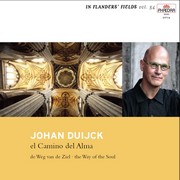
|
help |
Nederlands |

|
el Camino del Alma
Introduction by Johan Duijck |
|
el Camino del Alma The Camino del Alma (the way of the soul) is based on texts by three of the most important mystical poets from the golden age of the Spanish Renaissance, "el Siglo de Oro". Alma de la Música: opus 16 (1996). For soprano solo, choir and Orchestra. Based on the text of Fray Luis de León (1527 - 1591)One of Fray Luis de León's best friends was the blind organist of Salamanca Cathedral, Francisco Salinas (circa 1514 - 1590). His organ recitals were of an exceptionally high standard. The quality of his playing was mentioned by the composer Cristóbal de Morales, in his book Viaje (Travels). Moreover the interpretations of Salinas had an extraordinary spiritual character. This experience of the soul, the impact of the music on the listener's soul is what Fray Luis expresses through his poem Oda a Salinas. It is as if the soul is reborn (renaissance) through the heavenly sounds of the organ. It renounces evil practices and regains its original purity. Alma de la Música is an ode to the power of friendship and music and is dedicated to my dearest friend László Heltay. Cantar del Alma: opus 24 (2004). For contralto solo, choir and Piano. Based on the text of San Juan de la Cruz (1542 -1591)The eleven verses are separated by the refrain "Aunque es de noche" (although it is night). The composition begins with the recitative from the contralto solo. Each voice section of the choir (maybe divided up to four parts) then takes turns to be responsible for one of the following lines from the poem. Short meditative interludes are provided by the piano, which also introduces the "Fonte" theme (a spring's source), represented by a descending scale in 4th's. All of these themes are gradually developed in the 3rd and 4th verses. The general atmosphere is dreamlike and floating. The 5th verse is an aria for contralto solo and piano. In each composition I always try to write at least one spine - tingling melody. I wonder and hope I have achieved this. The central word used by San Juan in the next three verses is "corriente" (flowing) which is depicted by an outburst of energy from the choir. The last three verses are variations of the previous musical themes used in the first five verses. Cantar del Alma is dedicated to Juan and Maria-José de Izeta. Alma, búscate en Mí: opus 25 (2005). For mixed choir and Organ. Based on the text of St Teresa de Ávila (1515 -1582)The poem describes how God's voice can be heard in man's own soul. "O soul, you must seek yourself in Me, And you must seek Me in yourself " The dialogue between God and the soul is musically represented by a dialogue between a four part ladies' choir and three part men's choir. Of course, "Mí" (Me = God) is expressed by the note "mi" (e), and "ti" (yourself - the soul) by the note "si bemol" (b flat). The distance between these two notes is a tritone, the diabolus in musica. According to the law of reversibility, this "devil in music" symbolizes divinity here. In the heart of the composition (isla poetica) the choir disappears as text bearer and a single orator expresses the voice of God: "Porque tú eres mi aposento, mi casa y morada" (Because you are my shelter, my home and my resting place). It is as if God "prays" man to be in unison with Him and himself. God needs man. Alma, búscate en Mí is dedicated to Stefaan Vandewalle Johan Duijck (transl.: Goedroen Debroey & Lynne Gerrard) |
|
|||

|
Gents Madrigaalkoor
|
||
|
|
|||